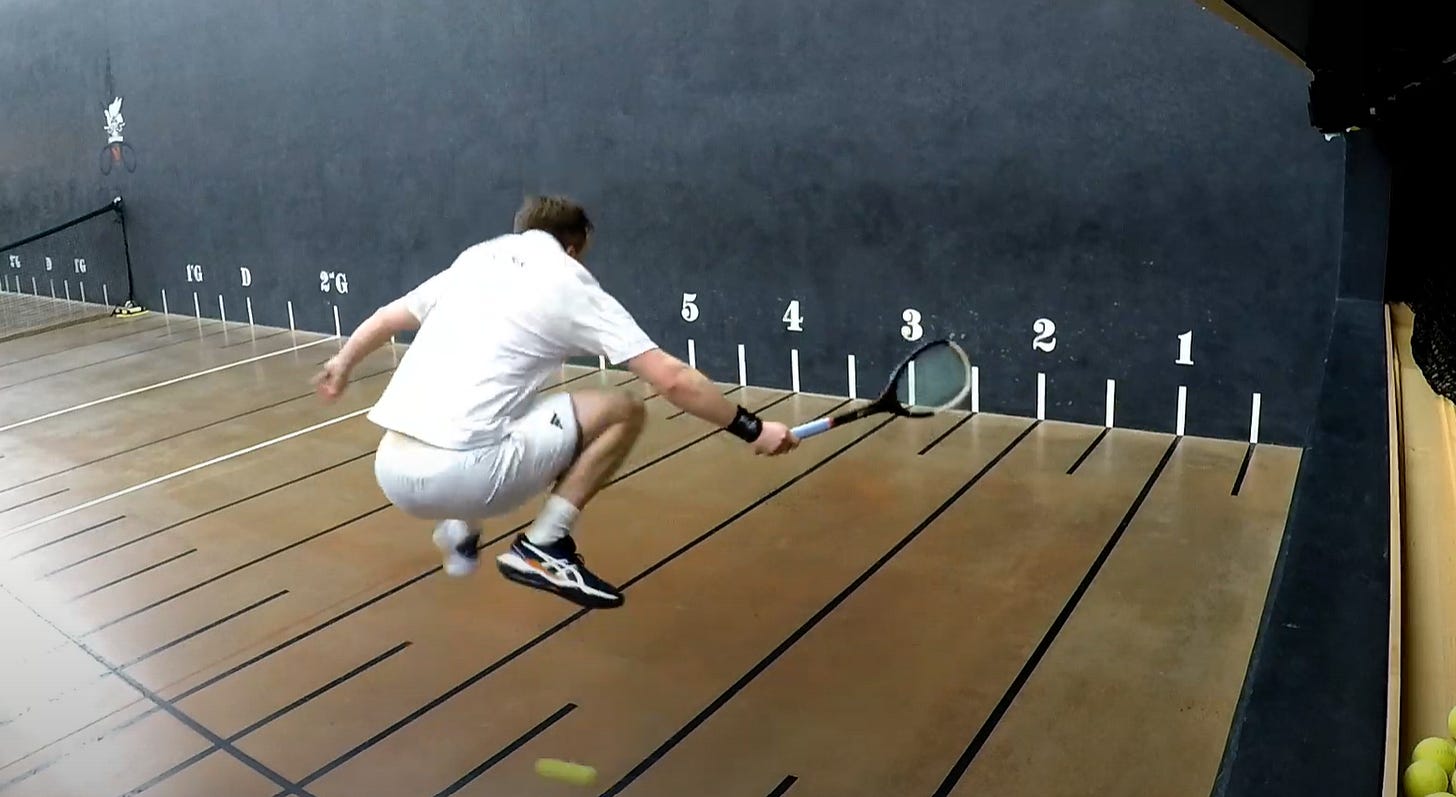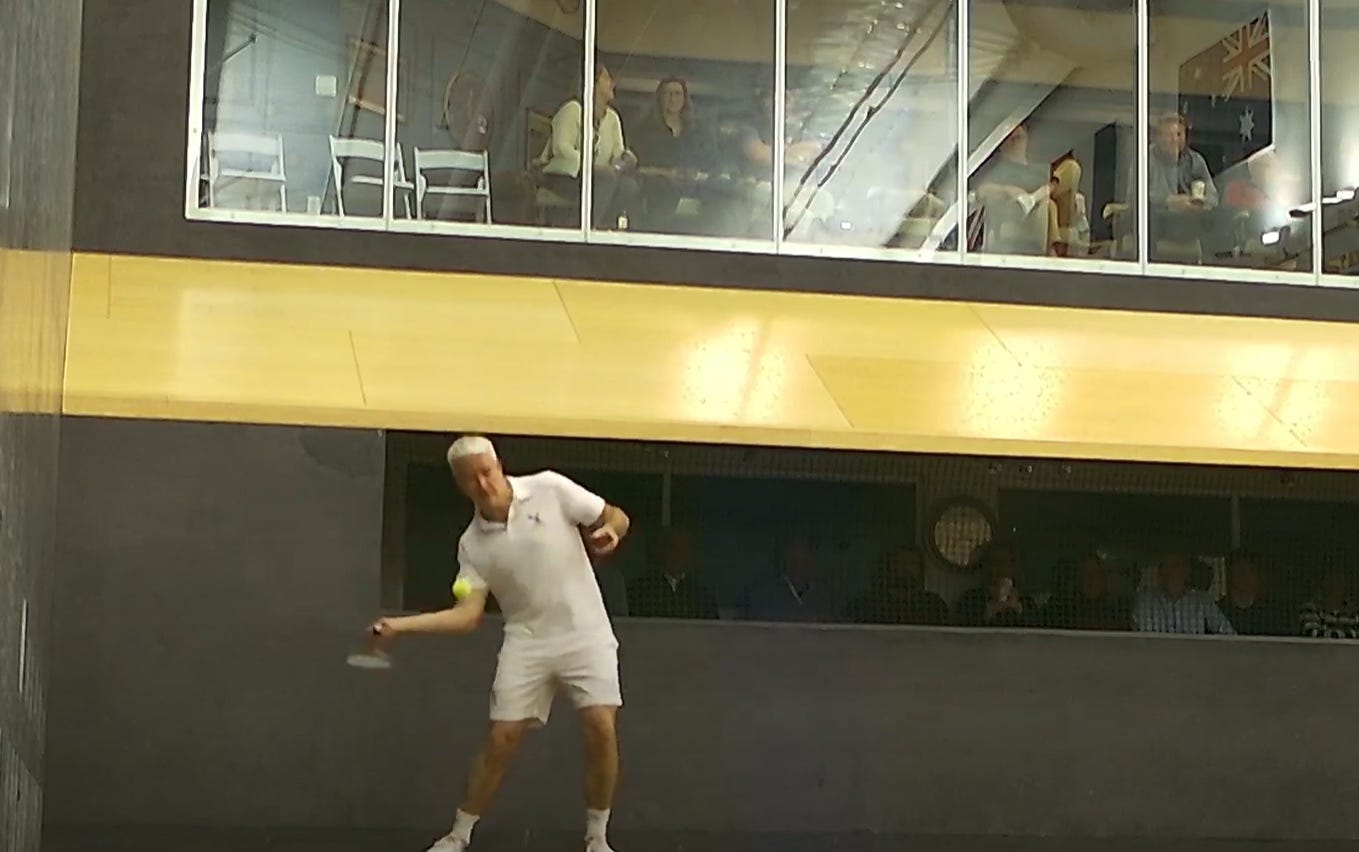Fahey downs Howell in US Open quarter final
Shenkman's challenge to Lumley falls at first hurdle
Robert Fahey has dealt a major blow to world number 3 Nick Howell’s preparation for the World Championship Eliminator next month, coming out on top of a high quality quarter final at the US Open on Tuesday.
Few players have ever stepped on court to face off against each other as often as Camden Riviere and Steve Virgona. And so it was again in the first quarter final. As he has done on so many previous occasions, Riviere made the game look easy. He played with an elegant grace matched with superior control, balancing the nagging play into the corners with pin-point accurate bullets into the targets. He quickly established himself as the front-runner early in the first set and never looked back. The firmest resistance from Virgona came at the start of the second set, with the Australian matching the American for a few games, before Riviere stormed ahead again. By the third set, Virgona was resigned to his fate, chalking up a 23rd consecutive loss against a rival whom he once boasted a winning record.
Despite announcing that morning that he was withdrawing from the doubles draw due to an ongoing shoulder injury, Leon Smart still took to the singles court in his quarter final against Ben Taylor-Matthews. Taylor-Matthews was excellent at absorbing the pressure from Smart, happily putting the ball back into difficult areas until Smart made the error. He was also very effective playing boasts onto the service battery wall. Smart persisted with his high giraffes, largely the only player in the tournament to be serving them on the Westwood court, but it gave Taylor-Matthews a good angle to target Smart’s backhand. Smart’s best run of play came in the third set, as Taylor-Matthews was set into cruise control. Ultimately, the result had not been in doubt, with Taylor-Matthews moving through to the unenviable semi final against Riviere.
The third match saw eighth seed Robert Shenkman challenge second seed John Lumley. At the start of the match, Shenkman was positive and attacking, looking for opportunities on the dedans or cutting the ball heavily into Lumley’s backhand. He took advantage of Lumley’s relative lack of recent match practice to match him shot for shot, as Lumley didn’t quite have the same clinical finish that he is capable of. Both players exhibited a different kind of rallying style, with Lumley scampering into the corners to dig balls out from his toes and Shenkman leaning into his ground strokes and volleys, boasting his way out of trouble. Neither player established any lead in the first set, leading to a deciding game. At deuce, with a worse than 3 chase pending, Shenkman missed a couple of opportunities on the grille, then hit a square tambour that came around all the corners right to where Lumley was standing, who obliged with a main wall dedans. The worse than 3 chase was not a problem for Lumley to defend, thus winning the first set.
Shenkman was managing to go toe to toe with Lumley through the first four games of the second set as well. However, Lumley lifted his game, winning through the final four games without letting Shenkman have a look in. Lumley was hitting his targets well. Meanwhile, Shenkman had reverted to his regular mode of play by pushing the ball around rather than attacking it. Shenkman broke his 6 game losing streak at 0-2 down in the third set, but by that point he looked as though he felt the match had slipped away from him. Lumley was fully on top, able to turn his defense into devestating attack. He was well played in by the end of the match, ready for a tough semi final on Thursday.
For just the second time in nearly six years, regular doubles partners Robert Fahey and Nick Howell lined up on opposite sides of the court in the final quarter final of the day. Unlike the previous match, the order of the day was target hitting, with both players lining up for the dedans at every opportunity they got. Fahey demonstrated why he was the player who revolutionised the target-hitting style of play several decades ago, hitting the ball with precision and purpose. Fahey seemed to have Howell’s game worked out, playing into all of his weaknessess. He quickly moved from 2-all to 5-2 in the first set. At deuce in the eighth game, Fahey served a high serve from deep in the court, which ran along the back wall flush. Howell stepped inside it and attempted to boast it back off the tambour wall, however he collected his knee with his racket in the process, sending himself to the floor keeled over in pain. He took an injury time out, hobbling to the side galleries. Upon his return, Fahey served the same serve, but this time it was not as tight, with Howell blasting a dedans in response. Ultimately, it was to no avail, as Fahey was able to hold on for the set.
Fahey’s momentum ran out at 2-0 in the second set. Howell started to get the better of the backhand rallies, finding effective winners to get out of the exchange. At 3-2 to Howell, Fahey tried to jump over a low force, only for it to tag him square on the outside of the ankle. Fahey tossed his racket across the court in pain, taking a breather before carrying on. The momentum was solidly with Howell, with Fahey playing half-hearted shots at the end of the set with the view to concede and restart for the third.
Fahey broke his six game losing streak at the start of the third set. He shifted through the gears, playing all manner of unconventional shots and unusual tactics, trying to catch Howell off guard. Howell was solid in response, absorbing the pressure and throwing in some shots of his own. The set was the most tightly contested of the match until Fahey got a break in the seventh game. He didn’t look back, going on to a 2-1 lead in sets.
Fahey slowed down the play going into the fourth set, trying to recover some energy from the push at the end of the previous set. He quickly found himself with an opportunity for a break. He made it by beating two short chases on the floor, then holding off Howell’s dedans onslaught with some of the best defensive volleys of the tournament so far. Fahey’s cut-volley was belligerent, and his ability to wind up a sprint on a big point to chase a ball into the corner was impressive for a 56 year old. By the end of the set, he was playing with an intensity not seen since the World Championship in Prested in 2022, determined not to give Howell any room to recover. Fahey moves on to his third Open semi final since his retirement, following the 2024 US Open and 2025 Australian Opens.
Fahey and Howell will team up for the doubles later in the tournament, however they will receive an unexpected rest day tomorrow due to the withdrawal of Leon Smart and Josh Dodgson from the doubles. The remaining three doubles quarter finals will take place as scheduled.
Match results:
12:00 noon: Camden Riviere (1) def Steve Virgona (6) 6/2 6/3 6/1
2:00 pm: Leon Smart (7) lost to Ben Taylor-Matthews (4) 3/6 1/6 4/6
4:00 pm: Robert Shenkman (8) lost to John Lumley (2) 5/6 2/6 1/6
6:00 pm: Nick Howell (3) Robert Fahey (5) 2/6 6/2 3/6 1/6
Order of play for Wednesday (all times EST):
12:00 noon: Camden Riviere & Tim Chisholm (1) vs Robert Shenkman & Louis Gordon
2:00 pm: John Lumley & Steve Virgona (2) vs Barney Tanfield & Freddie Bristowe
6:00 pm: Ben Taylor-Matthews & Nino Merola (4) vs Darren Long & Lewis Williams (6)
Robert Fahey & Nick Howell (2) receive a walkover from Leon Smart & Josh Dodgson (5)






Great commentary - as usual!